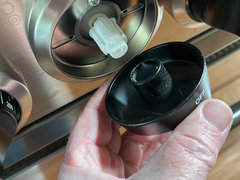Bluestar Simmer Fixed! Do's and Don'ts!
buffalotina
12 years ago
Featured Answer
Sort by:Oldest
Comments (14)
mojavean
12 years agolast modified: 9 years agoMichelleDT
12 years agolast modified: 9 years agoRelated Professionals
Gainesville Kitchen & Bathroom Designers · Bensenville Kitchen & Bathroom Designers · Cleveland Kitchen & Bathroom Remodelers · Green Bay Kitchen & Bathroom Remodelers · League City Kitchen & Bathroom Remodelers · Roselle Kitchen & Bathroom Remodelers · Santa Fe Kitchen & Bathroom Remodelers · Thonotosassa Kitchen & Bathroom Remodelers · Holt Cabinets & Cabinetry · Jeffersontown Cabinets & Cabinetry · Mount Holly Cabinets & Cabinetry · Oakland Park Cabinets & Cabinetry · Plymouth Cabinets & Cabinetry · Prior Lake Cabinets & Cabinetry · Prospect Heights Cabinets & Cabinetrytyguy
12 years agolast modified: 9 years agobuffalotina
12 years agolast modified: 9 years agothull
12 years agolast modified: 9 years agobuffalotina
12 years agolast modified: 9 years agotyguy
12 years agolast modified: 9 years agobuffalotina
12 years agolast modified: 9 years agoTXGuy
2 years agothull
2 years agoTXGuy
2 years agothull
2 years agojeffp42
2 years ago
Related Stories

KITCHEN APPLIANCESFind the Right Oven Arrangement for Your Kitchen
Have all the options for ovens, with or without cooktops and drawers, left you steamed? This guide will help you simmer down
Full Story
TASTEMAKERSPro Chefs Dish on Kitchens: Michael Symon Shares His Tastes
What does an Iron Chef go for in kitchen layout, appliances and lighting? Find out here
Full Story
KITCHEN DESIGNSo Over Stainless in the Kitchen? 14 Reasons to Give In to Color
Colorful kitchen appliances are popular again, and now you've got more choices than ever. Which would you choose?
Full Story
MOVINGThe All-in-One-Place Guide to Selling Your Home and Moving
Stay organized with this advice on what to do when you change homes
Full Story
KITCHEN DESIGNKitchen Counters: Durable, Easy-Clean Soapstone
Give bacteria the boot and say sayonara to stains with this long-lasting material that's a great choice for kitchen and bath countertops
Full Story
KITCHEN DESIGNHow to Find the Right Range for Your Kitchen
Range style is mostly a matter of personal taste. This full course of possibilities can help you find the right appliance to match yours
Full Story







thull